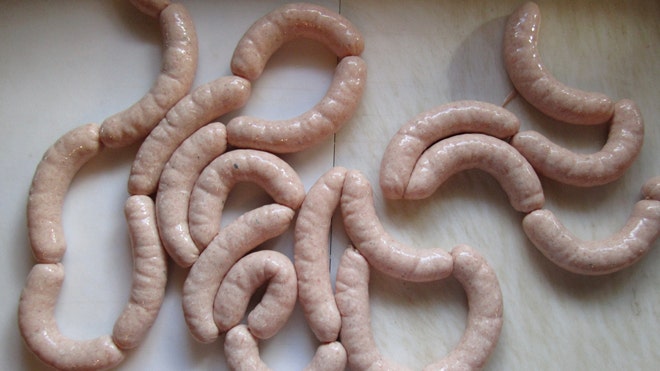Tips from the pros on making sausage at home

Sausage from Biercamp in Ann Arbor, Mich.Biercamp

Beef jerky from Biercamp.Biercamp

I grew up with homemade sausage on the table every week that my butcher Dad made in his shop. Those wonderful, chunky links of meaty goodness were one of the greatest, easy weeknight tricks for getting dinner served fast that my mom had up her sleeve.
"There's nothing more satisfying than making your own meats, and there's nothing more tasty than sausage."
- Jaime Stachowski, Stachowski Market & Deli
Grilled, baked, fried, steamed, roasted, cubed in a casserole or simmered in a sauce - pretty much any way you slice 'em, these compact sleeves of meaty goodness certainly are a crowd pleaser.
"Sausage is a flavorful, tasty package that's ready to go! And every nationality and culture has its own special flavor and style," says professional sausage maker Jaime Stachowski of Georgetown's Stachowski Market & Deli. "People come to me and say, 'Do you know this sausage?' And they'll still surprise me and show me something I've never heard of!"
But if the idea of attempting to make them at home leaves you feeling like you're searching for the missing link, it's not as impossible as all that. All you need is a cold 'fridge, good meat, a minimum of equipment, some casings (and, actually, sometimes you don't even need those), and a little advice from the experts.
"The most popular sausage we sell is breakfast sausage," says Walter Hansen of the sausage haven Biercamp in Ann Arbor, Mich. And he would know. "When I was 10, my dad put me in the meat room of his grocery store in Michigan. I made sausages and hot dogs and trimmed meat."
After getting his culinary degree, Hansen spent six years working at New York's Del Posto for Mario Batali (whose own Dad is quite the sausage pro), and moved back to Michigan where he and girlfriend Hannah Cheadle opened Biercamp, where they churn out fresh and smoked sausages, many from recipes handed down from his butcher dad and grandfather.
Hansen says breakfast sausage is a great recipe to start with because the ingredients are simple and you don't necessarily need to master the technique of stuffing it into links.
"You can form it into patties or use it bulk for holiday stuffing. I'd start with 1 pound for the first try, then work your way up in pound increments," he advises. "There are a lot of great recipes online." Just don't forget your seasoning, which is key in any sausage making.
For breakfast sausage, cracked black pepper, sage, and kosher salt are a great place to start (per my Dad: To avoid over-salting, stick to 1 ounce of salt per 5 pounds of meat, and adjust up or down accordingly).
Most home-mixer machines offer sausage making attachments, which are perfectly fine for small-batch home sausage making. Casings can be bought through your local butcher if he's willing to procure them for you, or online - just make sure you buy a natural, not synthetic, casing, so the cooked sausage has that delicious, edible "snap!" when you bite into it.
And what the meat? Most sausage makers I talked to recommended pork to start off with, and that Boston butt is the cut of choice.
If you decide to go with the picnic (e.g., rear section or the ham), beware -Stachowski says. It's a section with many glands that will mess with your ultimate flavor if they're not removed. Ask your butcher for a boneless picnic if that's your cut of choice. For Boston butt, just make sure you add about 15 percent extra fat into the grind.
"You can go higher in fat, but it's trickier to get great encapsulation and emulsification," says Stachowski, who recently has been providing nearly a dozen artisanal sausages for The Grill Room's Sausage & Rye Brunch at the Capella Washing D.C. hotel. "The higher quantity of fat you have means there's less protein to surround the fat particles."
Translation: You need the right ratio of meat to fat or your sausage will fall apart.
Next to the right amount of fat, the other extremely important thing to keep in mind when making sausage: Temperature.
"You want to keep it below 38 degrees Fahrenheit - the closer to 32 - 35, the better," implores Stachowski, who comes from a long line of Polish sausage makers back in upstate New York. "[The fat] will congeal and adhere and that's called emulsification. Above 51 degrees and it breaks apart. For me, I say that if you go above 40 you're in the danger zone of breaking apart."
Butchers also recommend grinding your meat twice. Stachowski says grind once, put your meat back in the refrigerator or even the freezer to keep the temperature down, and then pull it out and mix in the spices on the second round through.
When stuffing into cases, make sure you soak the casings to remove any salty residue used in preserving them. Then, carefully attach the end to your kitchen sink faucet, and run tepid water through them to rinse. When you're ready and your meat is cold enough, attach the casings and fill as instructed by your home machine, twisting into links about every 6 inches or so.
" There's nothing more satisfying than making your own meats," Stachowski insists. "And there's nothing more tasty than sausage.
0 comments:
Post a Comment